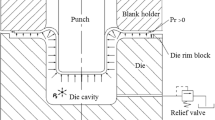Abstract
In deep drawing process, if the workpiece is not willing to wrinkle due to small drawing ratio, deep drawing is done without the blank-holder. In present paper, numerical analysis of hot deep drawing for the thick hemispherical head from a plate with the thickness of 63.5 mm which is made of alloy steel HY-100 is presented without using the blank-holder. The drawing process of hemispherical head is studied by using three different geometries of drawing die in three positions as (1) increase in the curvature radius of the die, (2) approximate tractrix and (3) exact tractrix. In this research, Johnson–Cook constitutive model is used in order to explain the flow behavior of the material and the damage model of Johnson–Cook is used for prediction of failure probability in the product. Also, it is assumed that the hot deep drawing is done as isothermal and the strain rate is fixed. The results of numerical analysis show that the probability of damage occurrence in the “exact tractrix” design is lower than the other designs. Also, comparison of the thickness distribution in the wall of hemispherical head shows that the “exact tractrix” design has the least fluctuation of change in the wall thickness. Comparison of drawing force obtained by the numerical analysis show that at the same conditions of blank temperature and friction coefficient, using the “exact tractrix” design can significantly reduce the needed force in order to draw the hemispherical head.












Similar content being viewed by others
Notes
Interstitial free.
Tailor friction stir welded.
Axisymmetric.
4-node bilinear axisymmetric quadrilateral, reduced integration, and hourglass control element.
Penalty method.
References
Yang X, Wang B, Zhou J, Dang L, Xiao W, and Wang Y, Int J Lightweight Mater Manuf 3 (2020) 36.
Tank Components Industries, www.tankcomponents.com (2000, accessed 2021).
Gibson J, and English J, Pressurized Rescue Module System (PRMS), OceanWorks International Corporation, North Vancouver (2002).
Al-Makky M M, and Woo D M, Int J Mech Sci 22 (1980) 467.
Sowerby R, Karima M, and Chakravarti P C, J Mech Work Technol 6 (1982).
Danckert J, Ann ClRP 44 (1995) 1.
Loganathan C, and Narayanasamy R, Mater Sci Eng A 406 (2005) 229.
Loganathan C, and Narayanasamy R, Mater Sci Eng A 419 (2006) 331.
Narayanasamy R, and Loganathan C, Mater Sci Eng A 419 (2006) 249.
Narayanasamy R, and Loganathan C, Mater Des 28 (2007) 904.
Sedighi M, and Rasti M, Int J Adv Manuf Technol 38 (2008) 958.
Narayanasamy R, Loganathan C, and Satheesh J, Mater Des 29 (2008) 1654.
Narayanasamy R, and Loganathan C, Mater Des 29 (2008) 1401.
Sivasankaran S, Narayanasamy R, Jeyapaul R, and Loganathan C, Mater Des 30 (2009) 3193.
Kesharwani R K, Basak S, Panda S K, and Pal S K, J Manuf Process 28 (2017) 137.
Zheng K, Lee J, Lin J, and Dean T A, Int J Mach Tools Manuf 114 (2017) 21.
Takalkar A S, and Chinnapandi L B M, CIRP J Manuf Sci Technol27 (2019) 56.
Liu Y, Zhu B, Wang K, Li S, and Zhang Y, Tribol Int 151 (2020) 106504.
Vahdati M, Rasooli M A, and Gerdooei M, J Solid Fluid Mech 10 (2020) 59.
Schoof C, Goland L, and Lo D, Pressurized Rescue Module System Hull and Transfer Skirt Design and Experimental Validation, OCEANS Conference, Vancouver, BC, pp 1–8, https://doi.org/10.1109/OCEANS.2007.4449295 (2007).
Oehler G, and Kaiser F, Blanking, Punching, and Drawing Tools, 6th edition, Springer, Berlin (1973).
Klocke F, Manufacturing Processes 4: Forming, Translation from the German edition ''Fertigungsverfahren 4: Umformen', Springer.https://doi.org/10.1007/978-3-642-36772-4 (2013).
Sellin W, Handbook of Drawing Technology, Springer, Berlin (1931).
MatWeb: Online Materials Information Resource, www.matweb.com, 1996–2021.
Holmquist T J, Strength and Fracture Characteristics of HY-80, HY-100 and HY-130 Steels Subjected to Various Strains, Strain Rates, Temperatures, and Pressures, Naval Surface Warfare Center, Maryland (1987).
Dassault Systèmes, http://www.3DS.com/simulia (2002, accessed 2021).
Siva Prasad K, and Srinivasa Rao C, Pyrex J Eng Manuf Technol 1 (2014) 1.
Shawki G, Bander Bleche Rohre, 10 (1969) 597.
Lange K, Handbook of Metal Forming, Society of Manufacturing Engineers, pp 20.1–20.69 (1985).
Johnson G R, and Cook W H, A Constitutive Model and Data for Metals Subjected to Large Strains, High Strain Rates, and High Temperatures, Proceedings 7th International Symposium on Ballistics, The Hague, 19–21 April 1983, pp 541–547 (1983).
Johnson G R, and Cook W H, Eng Fract Mech 21 (1985) 1.
Altan T, Ngaile G, and Shen G, Cold and Hot Forging: Fundamentals and Applications, ASM International (2005).
Schey J, Tribology in Metal-working: Lubrication, Friction, and Wear, American Society for Metals (1983).
Author information
Authors and Affiliations
Corresponding author
Additional information
Publisher's Note
Springer Nature remains neutral with regard to jurisdictional claims in published maps and institutional affiliations.
Rights and permissions
About this article
Cite this article
Vahdati, M., Gerdooei, M. Numerical Analysis of Hot Deep Drawing Process of the Thick Hemispherical Head Without the Blank-Holder. Trans Indian Inst Met 74, 1775–1786 (2021). https://doi.org/10.1007/s12666-021-02272-z
Received:
Accepted:
Published:
Issue Date:
DOI: https://doi.org/10.1007/s12666-021-02272-z



